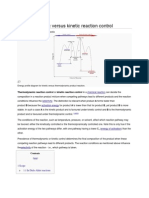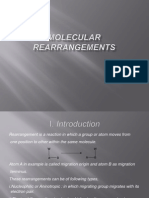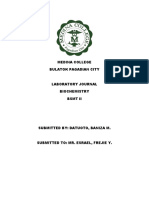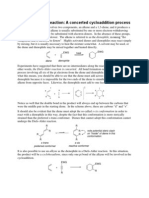Cannizaro Reactions
Cannizaro Reactions
Uploaded by
vrchemieCopyright:
Available Formats
Cannizaro Reactions
Cannizaro Reactions
Uploaded by
vrchemieOriginal Description:
Copyright
Available Formats
Share this document
Did you find this document useful?
Is this content inappropriate?
Copyright:
Available Formats
Cannizaro Reactions
Cannizaro Reactions
Uploaded by
vrchemieCopyright:
Available Formats
* The disproportionation reaction of aldehydes without -hydrogens in presence of a strong base to furnish an alcohol and a carboxylic acid is called
Cannizzaro reaction. One molecule of aldehyde is reduced to the corresponding alcohol, while a second one is oxidized to the carboxylic acid.
* The applicability of Cannizzaro reaction in organic synthesis is limited as the yield is not more than 50% for either acid or alcohol formed. * In case of aldehydes that do have -hydrogens, the aldol condensation reaction takes place preferentially. * The ,,-Trihalo aldehydes undergo haloform reaction in strongly alkaline medium. E.g. Choral will give chloroform in presence of an alkali.
MECHANISM OF CANNIZZARO REACTION
* The cannizzaro reaction is initiated by the nucleophilic attack of a hydroxide ion to the carbonyl carbon of an aldehyde molecule by giving a hydrate anion. This hydrate anion can be deprotonated to give an anion in a strongly alkaline medium. In this second step, the hydroxide behaves as a base.
* Now a hydride ion, H- is transferred either from the monoanionic species or dianionic species onto the carbonyl carbon of another aldehyde molecule. The strong electron donating effect of O- groups facilitates the hydride transfer and drives the reaction further. This is the rate determining step of the reaction.
* Thus one molecule is oxidized to carboxylic acid and the other one is reduced to an alcohol.
* When the reaction is carried out with D2O as solvent, the resulting alcohol does not show carbon bonded deuterium. It indicates the hydrogen is transferred from the second aldehyde molecule, and not from the solvent. * The overall order of the reaction is usually 3 or 4. * The Cannizzaro reaction takes place very slowly when electron-donating groups are present. But the reaction occurs at faster rates when electron withdrawing groups are present.
ILLUSTRATIONS & EXAMPLES OF CANNIZZARO REACTION
1) Formaldehyde is disproportionated to formic acid and methyl alcohol in strong alkali.
2) Benzaldehyde can be converted to benzoic acid and benzyl alcohol.
3) Furfural gives furoic acid and furfuryl alcohol in presence of strong alkali.
4) Crossed Cannizzaro reaction: When a mixture of formaldehyde and a non enolizable aldehyde is treated with a strong base, the later is preferentially reduced to alcohol while formaldehyde is oxidized to formic acid. This variant is known as crossed Cannizzaro reaction. E.g. Benzyl alcohol and formic acid are obtained when a mixture of benzaldehyde and formaldehyde is treated with alkali.
The reason may be: the initial nucleophilic addition of hydroxide anion is faster on formaldehyde as there are no electron donating groups on it. The preferential oxidation of formaldehyde in crossed Cannizzaro reactions may be utilized in the quantitative reduction of some aldehydes.
5) -keto aldehydes can be converted to -hydroxy carboxylic acids by an intermolecular Cannizzaro reaction. E.g. Phenylglyoxal undergoes intramolecular cannizzaro reaction by giving Mandelic acid (-hydroxyphenylacetic acid or 2-Hydroxy-2-phenylethanoic acid)
6) Phthalaldehyde can undergo intramolecular Cannizzaro reaction by giving (ohydroxymethyl) benzoic acid.
You might also like
- Aldol Condensation LabDocument6 pagesAldol Condensation LabChristian AmpeNo ratings yet
- Perkin ReactionDocument2 pagesPerkin Reactionrajaraghuramvarma100% (1)
- Experiment 8 The Preparation of AcetanlideDocument12 pagesExperiment 8 The Preparation of AcetanlideRadhwanNo ratings yet
- AzoDye Class 12 Investigatory ProjectDocument7 pagesAzoDye Class 12 Investigatory ProjectSarthak Sehgal29% (7)
- ReactionDocument54 pagesReactionAhmed ImranNo ratings yet
- 306 Cannizzaro ReactionDocument9 pages306 Cannizzaro Reactionayesha sanaNo ratings yet
- Experiment 8 Synthesis of An Azo Dye - The Coupling Reaction of Benzenediazonium Ion With Naphthalen-2-OlDocument9 pagesExperiment 8 Synthesis of An Azo Dye - The Coupling Reaction of Benzenediazonium Ion With Naphthalen-2-OlShivam SinghNo ratings yet
- Cannizzaro Reaction ReportDocument15 pagesCannizzaro Reaction ReportRafal A MkNo ratings yet
- Chapter 18 - Carbonyl CompoundsDocument9 pagesChapter 18 - Carbonyl CompoundsNabindra RuwaliNo ratings yet
- CHEM35 1 E7 Cannizzaro Reaction PDFDocument4 pagesCHEM35 1 E7 Cannizzaro Reaction PDFSherlHolmesNo ratings yet
- Experiment 8 Synthesis of An Azo Dye - The Coupling Reaction of Benzenediazonium Ion With Naphthalen-2-OlDocument9 pagesExperiment 8 Synthesis of An Azo Dye - The Coupling Reaction of Benzenediazonium Ion With Naphthalen-2-Olana pertiwiNo ratings yet
- Cannizarorxn 120207190937 Phpapp01Document71 pagesCannizarorxn 120207190937 Phpapp01Adrian PINo ratings yet
- Experiment 123456 1 PDFDocument18 pagesExperiment 123456 1 PDFHardi Ahmed100% (1)
- Expt6 Synthesis of An Alkyl Halide DraftDocument6 pagesExpt6 Synthesis of An Alkyl Halide DraftAnna Sophia EbuenNo ratings yet
- 06 Chapter 1Document63 pages06 Chapter 1Dintakurthi PrasanthNo ratings yet
- Cannizzaros ReactionDocument8 pagesCannizzaros Reactionabubakar siddiqueNo ratings yet
- Cannizzaro Reaction - Mechanism, Examples With IllustrationsDocument2 pagesCannizzaro Reaction - Mechanism, Examples With IllustrationsHanin Latpi0% (1)
- YlideDocument13 pagesYlidePharaoh talk to youNo ratings yet
- Formal Report Synthesis of An Alkyl HalideDocument7 pagesFormal Report Synthesis of An Alkyl HalideFerdinand Tamayo Cayabyab Jr.No ratings yet
- AcetanilideDocument7 pagesAcetanilideepsonme101No ratings yet
- Thermodynamic Versus Kinetic Reaction Control, Diffusion ControlDocument7 pagesThermodynamic Versus Kinetic Reaction Control, Diffusion ControlenvirocompNo ratings yet
- Mannich ReactionDocument4 pagesMannich ReactionSirisha NarapalliNo ratings yet
- Obtaining Pure Acetanilide From Crude Acetanilide by Recrystallization ProcessDocument5 pagesObtaining Pure Acetanilide From Crude Acetanilide by Recrystallization ProcessCharlot NavarroNo ratings yet
- ManualDocument8 pagesManualSweta Suman100% (1)
- Synthesis of An Alkyl HalideDocument4 pagesSynthesis of An Alkyl HalideJoseph CatiisNo ratings yet
- Chem 5-1st Post Lab DiscussionDocument41 pagesChem 5-1st Post Lab DiscussionJesselie SalayaNo ratings yet
- Aliphatic Hydrocarbons: LAB #1 Reactions of HydrocarbonsDocument7 pagesAliphatic Hydrocarbons: LAB #1 Reactions of HydrocarbonsJoshuaArryNo ratings yet
- Di Benz Al AcetoneDocument12 pagesDi Benz Al Acetonevicky_law_2No ratings yet
- Beckmann Rearrangement Cyclohexanone Oxime and Its Rearrangement to Ε-CaprolactamDocument4 pagesBeckmann Rearrangement Cyclohexanone Oxime and Its Rearrangement to Ε-CaprolactamElif YeşilyaprakNo ratings yet
- Benzoin Exp7Document4 pagesBenzoin Exp7Liz Hackett0% (1)
- Di Benz Al AcetoneDocument3 pagesDi Benz Al AcetoneKristine Mae De GuzmanNo ratings yet
- Organic Chemistry For USTH Students Lecture 2: Electrophilic Addition To C CDocument107 pagesOrganic Chemistry For USTH Students Lecture 2: Electrophilic Addition To C CminhminhNo ratings yet
- Mechanism of Cannizzaro ReactionDocument8 pagesMechanism of Cannizzaro ReactionDaniel LieNo ratings yet
- Catalytic Hydrogenations: Birch ReductionDocument9 pagesCatalytic Hydrogenations: Birch ReductionAnamikaNo ratings yet
- Anthranilic Acid PDFDocument20 pagesAnthranilic Acid PDFGlibNo ratings yet
- Recrystallization and Aspirin (Full)Document32 pagesRecrystallization and Aspirin (Full)Yosita RahmawatiNo ratings yet
- 310 Beckmann RearrangementDocument7 pages310 Beckmann RearrangementHussain ShahidNo ratings yet
- Iodoform ReactionDocument5 pagesIodoform Reactionmarwazohdi100% (1)
- Handout3 Schrock CarbeneDocument3 pagesHandout3 Schrock CarbeneMior AfiqNo ratings yet
- Lab Manual FGS0074Document8 pagesLab Manual FGS0074hash117No ratings yet
- Name Reactions YhcDocument5 pagesName Reactions Yhcpcyathish37100% (1)
- Molecular RearrangementsDocument158 pagesMolecular RearrangementsRamesh Katkam75% (4)
- Medina CollegeDocument20 pagesMedina CollegeOtencianoNo ratings yet
- Qualitative Analysis Formal Report - AlcoholsDocument3 pagesQualitative Analysis Formal Report - AlcoholsPrincess Alyssa Abid100% (1)
- Carboxylic Acid Lab ReportDocument7 pagesCarboxylic Acid Lab Reportretsen30002No ratings yet
- Synthesis of Azo DyeDocument9 pagesSynthesis of Azo DyeRia Mikaella LadreraNo ratings yet
- Aldol Condensation DiscussionDocument3 pagesAldol Condensation DiscussionDenisse Watt Cuarteros100% (8)
- Practical 5.15 Prep of An Azo DyeDocument2 pagesPractical 5.15 Prep of An Azo DyedeeyamullaNo ratings yet
- Paracetamol Synthesis: Preparation of Paracetamol (P-Acetomenophen)Document7 pagesParacetamol Synthesis: Preparation of Paracetamol (P-Acetomenophen)hussein alnasry100% (1)
- The Friedel-Crafts Reaction PDFDocument7 pagesThe Friedel-Crafts Reaction PDFIsaac Nicholas NotorioNo ratings yet
- Synthesis of AcetanilideDocument2 pagesSynthesis of AcetanilideMylene MendozaNo ratings yet
- Don't Trust MeDocument2 pagesDon't Trust Memark pascuaNo ratings yet
- Synthesis of EstersDocument2 pagesSynthesis of EstersLawrenceDeJesusNo ratings yet
- Chapter 11-Reactions of Alcohols: 3° Alcohols Are Resistant To OxidationDocument30 pagesChapter 11-Reactions of Alcohols: 3° Alcohols Are Resistant To Oxidation張湧浩No ratings yet
- ATQDocument2 pagesATQCamille QuiñonesNo ratings yet
- Carbonyl Compounds Aldehydes KetonesDocument58 pagesCarbonyl Compounds Aldehydes KetonesNur Aliyah Abdul RazakNo ratings yet
- Inorganic Prac 2Document3 pagesInorganic Prac 2Ray DyerNo ratings yet
- 06 Chapter 1Document63 pages06 Chapter 1Kautsar NurfalaqNo ratings yet
- Homework 803 (1)Document15 pagesHomework 803 (1)Vaishnavi TyagiNo ratings yet
- Chapter 12 Mechanism of Reaction: Aldol CondensationDocument17 pagesChapter 12 Mechanism of Reaction: Aldol CondensationTiya KapoorNo ratings yet
- Organic MaterialDocument15 pagesOrganic MaterialAditya GathwalaNo ratings yet
- Chirality Practice Problems Answer KeyDocument7 pagesChirality Practice Problems Answer Keyminhshen5168No ratings yet
- The Diels-Alder Reaction: A Concerted Cycloaddition Process: EWG + EWG HeatDocument3 pagesThe Diels-Alder Reaction: A Concerted Cycloaddition Process: EWG + EWG HeatNanik WijayantiNo ratings yet
- Chemistry SyllabusDocument83 pagesChemistry SyllabuskameshNo ratings yet
- IGCSE Chemistry Section 5 Lesson 3Document43 pagesIGCSE Chemistry Section 5 Lesson 3Bhawana Singh100% (1)
- Chapter 4 Aromatic HydrocarbonsDocument34 pagesChapter 4 Aromatic HydrocarbonsAbdirashid Adam IsakNo ratings yet
- 2015 F6 Mock P2 PDFDocument7 pages2015 F6 Mock P2 PDFKaylie WongNo ratings yet
- Structure and Functions of Biological Molecules: at The End of The Lesson, You Are Expected ToDocument4 pagesStructure and Functions of Biological Molecules: at The End of The Lesson, You Are Expected ToFrancinne MartinNo ratings yet
- Alcohol VainillicoDocument3 pagesAlcohol VainillicoLuis GnzlzNo ratings yet
- Chem 31.1 Expt 8 Lab ReportDocument30 pagesChem 31.1 Expt 8 Lab ReportJohn Christian LopezNo ratings yet
- Formal Report For Synthesis of An Alkyl HalideDocument5 pagesFormal Report For Synthesis of An Alkyl HalideLovelyn Marie Morada Nievales80% (5)
- Chemistry Class 12 SyllabusDocument5 pagesChemistry Class 12 Syllabusakankshakumari8579No ratings yet
- CH 14Document10 pagesCH 14Noor Farrah Wahida MuradNo ratings yet
- Chloroform - Memory Map: ReactionsDocument1 pageChloroform - Memory Map: ReactionsAryan GuptaNo ratings yet
- Daftar Singkatan JurnalDocument46 pagesDaftar Singkatan Jurnalbaharudin100% (10)
- Hydrocarbon SlidesDocument33 pagesHydrocarbon Slidesmarianabolar100% (1)
- 10.1 Organic NitrogenDocument23 pages10.1 Organic NitrogengoverotaropafadzwaNo ratings yet
- HPSC PGT Previous Year Question Papers 2023 ChemistryDocument4 pagesHPSC PGT Previous Year Question Papers 2023 ChemistryAman KumarNo ratings yet
- IUPAC Names and NomenclatureDocument10 pagesIUPAC Names and NomenclatureAyushNo ratings yet
- General Organic Chemistry 12-10-23Document2 pagesGeneral Organic Chemistry 12-10-23adityareddyrocket1No ratings yet
- Synthesis of Poly (Lactic Acid) A ReviewDocument26 pagesSynthesis of Poly (Lactic Acid) A ReviewTOUFIK0% (1)
- Iupac Name QuestionDocument16 pagesIupac Name Questionayesha sheikhNo ratings yet
- # FC - 21-01-2024 - 3 Year SRG (PRKTN-A4)Document14 pages# FC - 21-01-2024 - 3 Year SRG (PRKTN-A4)Ashok KumarNo ratings yet
- S2 Q4: Organic Chemistry Organic Compounds and HydrocarbonsDocument14 pagesS2 Q4: Organic Chemistry Organic Compounds and HydrocarbonsMenaga A/P IlangkovanNo ratings yet
- Name ReactionsDocument10 pagesName ReactionsMUKUL SINGHNo ratings yet
- 14 Reaction Mechanism 2Document23 pages14 Reaction Mechanism 2English words BY Utkarsh johriNo ratings yet
- FFR 3Document9 pagesFFR 3api-216493934No ratings yet
- Chapter 8 Nucleophilic Acyl SubstitutionDocument51 pagesChapter 8 Nucleophilic Acyl SubstitutionHalimatun MustafaNo ratings yet
- Peracid Oxidation of Amines To NitroalkanesDocument3 pagesPeracid Oxidation of Amines To NitroalkanesSunny ChosaNo ratings yet
- JACS 1998 SN2 SN2 Pathway ExampleDocument10 pagesJACS 1998 SN2 SN2 Pathway ExampleRobertNo ratings yet

























































































